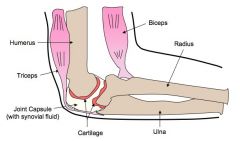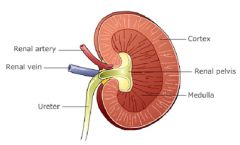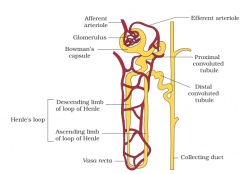![]()
![]()
![]()
Use LEFT and RIGHT arrow keys to navigate between flashcards;
Use UP and DOWN arrow keys to flip the card;
H to show hint;
A reads text to speech;
26 Cards in this Set
- Front
- Back
|
Whats the difference between skeletal system, muscular system and nervous system? |
skeletal: consists of bones that act as levers and provide a a structure for the muscles to pull muscular: muscle deliver the force required to move one bone in relation to another nervous: delivers signals to the muscles with cause them to contract and create movement |
|
|
What is a synovial joint? |
a joint that allows movement between two bones; it is lined by a synovial membrane, which produces synovial fluid for lubrication (another example of a joint is the ball and rocket joint) |
|
|
Label the elbow joint. |

|
|
|
What is the organisation of skeletal (striated) muscle? |
muscle - muscle fibre - myofibril - sarcomeres |
|
|
What are sarcomeres made up of? |
- the thick filament (myosin) contains small protruding heads which bind to region of the thin filament (actin) - Z lines hold the myofilaments in place |
|
|
Describe the process of muscle contractions. |
Depolarisation and calcium ion release - nerve impulses (action potential) - the impulse spread along the membrane of sarcoplasmic reticulum causing Ca2+ ions to be released Actin and myosin form cross bridges - before contraction, binding sites on actin filaments are covered by two molecules troponin and tropomyosin. - at a relaxed state the two molecules cover the biding site Sliding mechanisms of acting and myosin - as Ca2_ ions arrive, the bidding sites are exposed and myosin heads bind to the actin, forming cross bridges - cross bridges release in organic phosphate and ADP Sarcomeres shortening (muscle contracting) - the repeated reorientation of myosin heads drag the actin filaments along the myosin - as actin filaments are anchored to Z-lines, the dragging of actin pulls the Z-lines closer together shortening the sarcomere - As the sarcomere shorten in length the muscle fibre as a whole contracts (when contracted a darker band appears) - new ATP molecules break the cross bridges and detach them from actin filaments - the myosin head return to original state - if muscle is further stimulated the process is repeated and myosin heads attach further |
|
|
'muscles work in antagonist pairs'. What does this mean? |
antagonistic pairs: one muscle of the pair causes a movement in one direction while the other returns it to its original position |
|
|
Define osmoregulation. |
osmoregulation is the control of the water potential of body fluids to maintain and constant internal environment in the blood, tissue fluid and cytoplasm. It is achieved by regulating water and salt balance of body fluids |
|
|
Whats the difference between osmoregulators and osmoconformers? |
osmoregulators: able to osmoregulate by maintaining a constant internal environment osmconformers: unable to osmoregulate internally, so fluctuating according to outside |
|
|
Describe how sea water affects a freshwater fish. |
can't be placed in sea water because the solute concentration is twice as high as that of its blood. fish will therefore lose water by osmosis via its gills (permeable). If placed in freshwater able to absorb reabsorb vital salts |
|
|
What are the parts in the human kidney? |

|
|
|
Describe what occurs at the glomerulus.
|
Ultrafiltration and the glomerulus - occurs in the glomerulus in the Bowman Capsule, enters the afferent (approaching) arteriole at high pressure - blood plasma, containing excess glucose, water, salts and urea, enter the capillary of the glomerulus (basement membrane) and exit the capillary through pores called fenestration - only small molecules can pass the pores so plasma can't leave - blood that passes is called filtrate, those that don't fit leave the efferent arteriole (exists) |
|
|
What is the structure of a nephron? |

|
|
|
What occurs after filtrate passes glomerulus? |
reabsorption in the proximal convoluted tubule - reabsorbs useful substances (water, glucose, ions) - wall of tubule has microvilli to increase its surface area - have mitochondria brought by intertwining capillaries to fuel active transport the loop of Henle - descending limb is permeable to water so reabsorption of water - ascending limb is impermeable to water, so reabsorption of salt - the ascending limb creates high solute concentration in tissue fluid, which in return causes loss of water in descending limb - the longer the loop greater chance water is absorbed the distal convoluted tubule and the collecting duct - last absorption of water (depending on the permeability of duct controlled by ADH) - if ADH is activated then it becomes more permeable and water is taken back. if not urine becomes more dilute |
|
|
What molecules enter and what remains in the kidney? |
enters: water, glucose, salts, urea exists: urea, water and glucose (only when there is already a lot) protein should not be located in a healthy person, because it is too big to pass. |
|
|
What factors inhibit the secretion of ADH? |
caffeine, alcohol, cold conditions (stress and nicotine increase ADH) |
|
|
What waste product is excreted by insects and aquatic invertebrates? |
ammonia - very toxic, but require water as it quickly is diluted uric acid - they require less water to excrete from the body; animals are constantly truing to save water |
|
|
What treatment can you receive if your kidney begins to fail? |
hemodialysis -blood is withdrawn from a vein and passed through tubes made of partially permeable membrane - it introduces fresh dialysis fluid and removes wastes to maintain an appropriate concentration gradient - have to be connected for up to 8 hours at a time (this is a temporary solution, a permanent one includes getting a kidney transplant) |
|
|
Describe the processes in spermatogenesis for the formation of spermatozoa (sperm). (production of mature sperm cell in the testis) |
takes place in adult male - spermatogenisis describe the production of spermatozoa (sperm) in the seminiferous tubules of the testes - the process begins at puberty when the germinal epithelium of the seminiferous tubules divide by mitosis - these cells (spermatogonia) then undergo a period of mitosis, becoming primary spermatocytes - the spermatocytes undergo two meiotic divisions first to form secondary spermatocytes and secondly to form four haploid daughter cells (spermatids) - the spermatids then attach to sertoli cells (nurse cells) which aid the spermatids with differentiating by providing nourishment and turns into spermatozoa - spermatozoa develop their tails and detach from the sertoli cells and carried to the epididymis
|
|
|
What three hormones control sperm production? |
- FSH, stimulates meiosis in spermatocytes, to produce haploids - Testosterone, stimulates the maturation of secondary spermatocytes into mature sperm cells - LH, stimulates the secretion of testosterone from the testis |
|
|
How is semen formed? |
produced by two seminal vesicles and and the prostate gland. it is rich in fructose, which provides energy for the sperm cells to swim. prostate gland produces an alkaline fluid that helps sperm cells to survive in acidic conditions of the vagina |
|
|
Describe the processes in oogenesis for the formation of ova (egg cells). |
begins in the ovaries when she is a foetus - oogenia, the germinal epithelial cells within the ovaries divide by mitosis - these enlarge to form primary oocytes (diploid) but stop at prophase 1 and form primary follicles - development new ceases and continues during puberty
- during each menstrual cycle, only a few follicle will start the first division of meiosis, only one will fully complete its development (two haploid cells) - the cytoplasm develops unequally so one is bigger than the other. the bigger cell is the secondary oocyte and the smaller one is the polar body - the polar body degenerates and does not develop - the secondary oocyte protected with a follicle, beings meiosis 2 but stops at prophase 2 - at the point of ovulation, the follicle bursts and the secondary oocyte floats towards the oviduct - one fertilisation it completes it development and expels a second polar body (known as corpus luteum) |
|
|
Describe what occurs during human fertilisation. (form a zygote) |
(occurs at the oviduct) - sperm cells approach the zone pellucida, and undergo the acrosome reaction - acrosomes release enzymes, to penetrate the outer layers of the follicle cells covering the secondary oocyte - many sperm cells must be present to release the contents of their acrosomes but only one passes through - activates the cortical reaction, prevent polyspermy (entry of more than sperm cell nucleus) - cortical granules inside oocyte release content at plasma membrane so no more sperm is allowed to attract and fuse |
|
|
Describe what happens once a zygote is formed . |
- zygote divides by mitosis to form blastocyst - move down the oviduct towards the uterus and settles in the endometrium lining - once established starts to secrete hormone HCG; its role is to maintain the corpus luteum, so that it grows and continues to produce hormones for the first trimester (progesterone, oestrogen) - once the placenta forms the corpus luteum degenerates - a foetus is formed and is connected to an umbilical cord and is surrounded by fluid-filled sac called amnion (amniotic fluid) which supports the baby |
|
|
What is the role of the placenta? |
- produces hormones - disposal of foetal waste - blood flow (outer layers of placenta: chorion, chorionic villi are rich in capillaries) - exchange of material (oxygen, nutrients, water, alcohol, viruses) - suppresses menstrual cycle - promotes growth of breast tissue for lactation |
|
|
What are some of the hormonal changes right before childbirth? |
- progesterone and oestrogen are being made less by placenta - uterus contracts - stimulates pituitary gland to secrete oxytocin (stmulates the uterus muscles to continue their contractions) - cervix widens and amniotic sac breaks - baby and placenta is pushed out - after birth levels of prolactin increase (stimulates milk production from mammary glands) - oxytoxcin levels release causes milk to be released |

